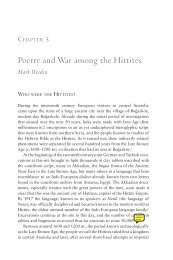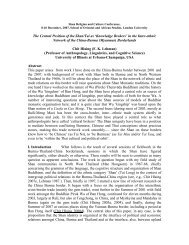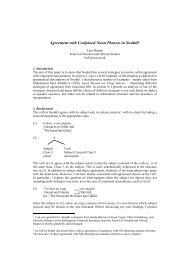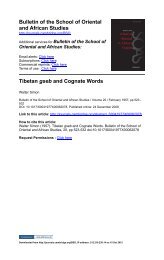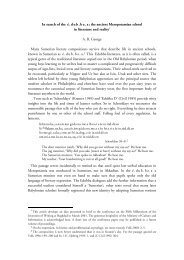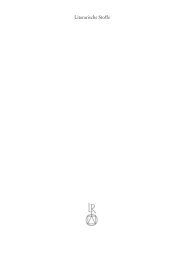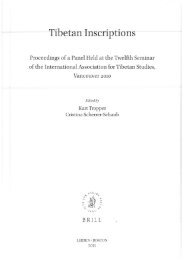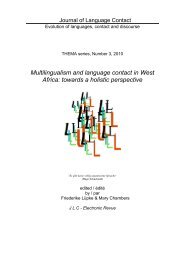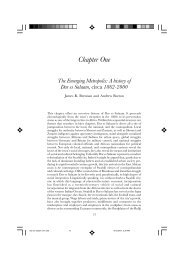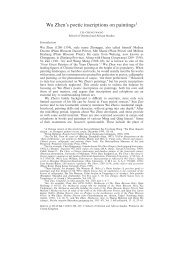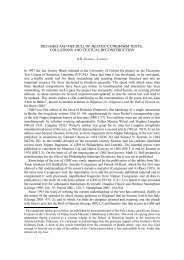Download (316Kb) - SOAS Research Online - The School of ...
Download (316Kb) - SOAS Research Online - The School of ...
Download (316Kb) - SOAS Research Online - The School of ...
Create successful ePaper yourself
Turn your PDF publications into a flip-book with our unique Google optimized e-Paper software.
indo-iranian gar ‘to raise al<strong>of</strong>t’ 251<br />
Avestan. Insler’s syntactic argument, however, although superficially attractive,<br />
is not quite so compelling because the construction involving the weapon in the<br />
accusative and the object hit in the locative is also found in the case <strong>of</strong> other<br />
roots from this semantic field. For instance, it holds equally well for Bailey’s<br />
Vedic cognate jigharti. More seriously, there is the palaeographic observation,<br />
not addressed by Insler, that the signs n and r are not usually confused. 17 <strong>The</strong><br />
spelling <strong>of</strong> w, n, ‘ and r by the same vertical stroke in the Pahlavi script was<br />
disambiguated by the inventor <strong>of</strong> the Avesta script. While the vertical stroke is<br />
used for n only, r is graphically represented by the letter l <strong>of</strong> the Pahlavi script. 18<br />
As a result, in the extant manuscripts n and r differ distinctively in so far as n<br />
is either a straight or a wavy short vertical stroke while the upper part <strong>of</strong> r slants<br />
upwards to the left and rises well above the main body <strong>of</strong> the text.<br />
A graphic confusion <strong>of</strong> r and n being unlikely, the emendation could be made<br />
plausible with the phonetic argument that x niγnāire was assimilated to niγrāire<br />
during the course <strong>of</strong> oral tradition, possibly under the influence <strong>of</strong> Mithra’s epithet<br />
grantō, which occurs repeatedly in the context <strong>of</strong> the verbal form. 19 <strong>The</strong> postulated<br />
assimilation <strong>of</strong> x niγnāire to niγrāire should have resulted from a Vulgate<br />
pronunciation which at some point entered the manuscript tradition <strong>of</strong> F1’s ancestors.<br />
Such corruption would have happened fairly early in the transmission <strong>of</strong><br />
the text because <strong>of</strong> the consistent spelling with -r- in the manuscripts belonging<br />
to the F1-line. Although Geldner, Avesta II 134 does not record any variant<br />
readings, a manuscript which he did not have at his disposal when editing the<br />
Avesta does yield decisive support to Insler’s emendation: a spelling with -n- is<br />
attested in ms. J 18 <strong>of</strong> J. M. JamaspAsa’s collection, where the reading is niγnāiri<br />
the first time (fol. 138v l. 4) and niγrāira the second (fol. 138v l. 9). Although<br />
J 18, dating from 1827 A. D., is a recent and <strong>of</strong>ten incorrect manuscript, the reading<br />
with -n- is likely to be lectio difficilior because the unique position taken by<br />
J 18 is confirmed by numerous other instances <strong>of</strong> variant readings which suggest<br />
that this manuscript was either influenced by, or even belonged to, a tradition<br />
independent <strong>of</strong> F1. 20 Since all mss. <strong>of</strong> the F1-line transmit the reading with -r-,<br />
17 Cf. also the cautioning comment by Kellens, Noms-racines 152 n. 3. <strong>The</strong>re is, however,<br />
rare evidence for confusion <strong>of</strong> r and n in Yt 15.53, where K40 has vīmrkre whereas<br />
F1 and other mss. have vimankar. Confusion <strong>of</strong> the two signs is assumed by Humbach<br />
1973, 188 in Vd 18.4, where he emends aˇstr am x ainīm for aˇstr am mairīm edited without<br />
variants by Geldner, Avesta III 112.<br />
18 H<strong>of</strong>fmann 1971, 72 (= Aufs. I 324).<br />
19 I owe some clarification <strong>of</strong> this point to a discussion with P. O. Skjærvø.<br />
20 <strong>The</strong> manuscript is described by Hintze, Zamyād-Yaˇst 56 and 1989, 45-48. Another<br />
Khorde Avesta and Yaˇst codex, J19, <strong>of</strong> J. M. JamaspAsa’s collection was equally not<br />
at Geldner’s disposition, but, like J18, was kindly made available to me by Dastur Dr.<br />
K. M. JamaspAsa. Yt 10.40 is on fol. 198r l. 3-7, but unfortunately, the first section from<br />
kartacit to vouru.gaoiiaoitiˇs has been omitted by the scribe. In the second half <strong>of</strong> the<br />
stanza,<br />
˜<br />
beginning with vazracit , the reading <strong>of</strong> the verbal form is corrupt: ne garāre<br />
˜



